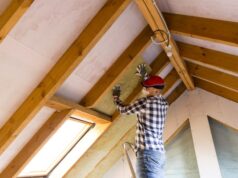
Doors do more than separate rooms or secure a home—they define the look and feel of a space. Whether you’re building new or renovating, the type of door you choose plays a key role in the layout, performance and overall style of your home.
From space-saving designs to statement-making entrances, here’s a rundown of the most common types of residential doors and where they work best.
Hinged doors
Hinged doors are the most familiar and widely used door type. They consist of a single panel attached to a frame with hinges on one side, swinging inwards or outwards. This category includes both internal and external doors.
They’re versatile, reliable and easy to install—ideal for bedrooms, bathrooms and entryways. You’ll also find them in custom configurations, like oversized pivot doors for striking entries.
Sliding doors
Sliding doors operate by gliding along a track parallel to a wall, making them ideal for rooms where swing space is limited. They’re commonly used to connect indoor and outdoor spaces and are often specified in aluminium or timber frames with glass inserts.
Sliding doors can be a great way to increase natural light and airflow. If you’re installing them in a living area or connecting to a deck, consider thermal efficiency, particularly in cooler climates.
Bi-fold doors
Bi-fold doors consist of multiple panels that fold back onto each other. When opened, they allow for wide, unobstructed openings between rooms or to the outdoors.
They’re popular for entertaining spaces, such as living rooms that open onto a deck or patio. Find out more about how they work in our bi-fold doors guide.
French doors
French doors are hinged double doors, usually featuring glass panels and often opening outwards onto gardens, balconies or courtyards. They add a traditional, elegant feel to homes and work well where both function and aesthetics matter.
If you’re planning to install French doors externally, ensure they meet energy efficiency and weather-sealing requirements.
Cavity sliding doors
A cavity sliding door disappears into a wall cavity when open, saving even more space than a traditional sliding door. These are often used in smaller homes, ensuites, wardrobes or between rooms where a full swing arc isn’t practical.
While they look clean and minimalist, installation can be more involved—especially in retrofits—so it’s worth reading up on installation practices.
Pivot doors
A pivot door is a type of hinged door, but instead of being attached to the side of a frame, it rotates on a pivot point at the top and bottom. These are typically large, heavy doors used at front entrances for a modern, architectural effect.
They require precise framing and strong hardware. When installed correctly, pivot doors can create a sense of grandeur and drama.
Louvered doors
Louvered doors include horizontal slats that allow airflow, even when closed. They’re ideal for wardrobes, pantries and laundry rooms where ventilation is important. Timber and MDF versions are the most common.
You’ll find louvered panels also used in outdoor situations, often combined with pergolas or custom enclosures to help promote air circulation.
Flush panel and solid-core doors
Flush panel doors have a smooth surface and are commonly used for interiors. They’re usually hollow-core, which keeps them light and affordable. Solid-core versions, on the other hand, are denser and offer better soundproofing and durability.
Solid-core or solid timber doors are a better option for bedrooms, media rooms or anywhere privacy and acoustic control are important.
Custom and feature doors
If your space is non-standard or you’re after something unique, custom doors allow you to select everything from size and material to finish and glazing. They’re often used in entryways or as statement pieces inside a home.
Custom designs can be made from timber, steel, fibreglass or even recycled materials. Just be sure to factor in installation requirements and framing when planning.
Choosing the right type
Ultimately, your choice of door will depend on its location, how you use the space and the aesthetic you’re after. Don’t forget to consider practicalities like door swing, insulation and exposure to weather when choosing.
To explore material options, check out our article on types of door materials. Or for a complete overview of everything from acoustic performance to thermal efficiency, explore our performance considerations guide.
Let your doors do more than just open and close—they should elevate the spaces they serve.





